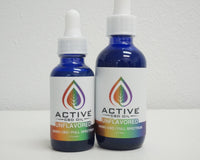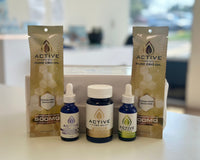Introduction; What is PTSD?
PTSD is a psychiatric condition that may develop in people (of all ages) who witness or endure a traumatic event or series of traumatic events. These events may be life threatening or pose a significant threat to a person’s physical, mental, emotional, or spiritual well being. A trauma or traumatic event can be defined as something that severely threatens your life or sense of safety. It does not have to be a single event as it can be a long-term trauma that you endure or witness. Some examples of trauma may include:
-
Physical, Mental, or Sexual Abuse
-
Serious Accidents (Like a Car Accident)
-
Bullying
-
War/Conflict
Types of PTSD; How Common is it?
One type of PTSD is Acute Stress Disorder. Acute Stress Disorder is a short term mental condition that can happen within the first month after experiencing a traumatic event. Though, if the symptoms last longer than four weeks they may meet the criteria for PTSD.
Another form of PTSD is CPTSD. CPTSD (Complex PTSD) is a mental health condition that can develop if you experience chronic (long-term) trauma. Examples of chronic trauma may include, long term physical or sexual abuse, or long term domestic violence and war, etc. Individuals who have CPTSD typically have PTSD symptoms, as well as extensive issues with emotional regulation, sense of self, and sometimes relationships too.
How Common is PTSD?
PTSD in itself develops in 5-10% of people who’ve experienced trauma according to an article written by Cleveland Clinic. As far as Acute Stress Disorder and CPTSD, it is hard to get a definitive answer as to how common it is for various reasons. One reason being that the rates differ according to which kind of trauma an individual may be experiencing. According to multiple studies, Acute Stress Disorder (ASD) can develop in 6-33% of people who experience trauma. This is a wide percentage due to the fact that oftentimes people don’t know they have this condition until they experience more of the symptoms of PTSD itself.
As far as CPTSD, it is a relatively new diagnosis, so research is slightly lacking on how common it actually is. What experts know so far is that it affects 1-8% of the world population.
Symptoms/Causes of PTSD:
Some common symptoms of PTSD include, intrusion, avoidance, changes in mood & thinking, as well as changes in arousal and activity. PTSD can also cause other conditions or diagnosis in turn such as ADHD, anxiety, and in some cases substance abuse disorders. Some more specific examples of PTSD symptoms are:
-
Intrusive thoughts, or memories that may repeat consistently.
-
Nightmares/Flashbacks that feel very real, as if you’re in that moment.
-
Ongoing fear, horror, guilt, or shame.
-
Detachment/Struggles with being positive.
-
Problems concentrating or sleeping.
-
Hypervigilant/Easily startled
-
Memory loss about specific aspects of the event.
How PTSD Affects Parts of the Brain:
Now that we know what PTSD is and how it can affect individuals, let’s get into how it can affect different parts of the brain. First, let’s get familiar with the areas of the brain that PTSD affects.
The amygdala, prefrontal cortex, and hippocampus are all areas that become magnified or demagnified depending on how severe the PTSD is and what specific trauma is endured. This means that these areas of the brain can be increased or decreased with certain activity depending on the severity of the symptoms that are being experienced by the person with PTSD. The image to the right shows a comparison of a brain with and without PTSD. The brain with PTSD, you can clearly see a lot more yellow & orange color, especially in the prefrontal cortex. This is all the excess neuronal activity that goes on in the brain when you’re observing your surroundings or making decisions. This is why a person with PTSD is potentially more hypervigilant, and irrational when regulating their emotions or making decisions.
Amygdala:
So, the Amygdala is responsible for fear generalization, processing rewards, and arousal. In other words, “Your amygdala triggers your natural alarm system.” (quote from Brainline Article) With PTSD, your Amygdala tends to have an overactive (magnified) response since that part of your brain is wired to ensure your survival. When it’s overactive, it can be hard to think rationally. A good example of this is a veteran survivor who may struggle around 4th of July. A firework would likely not bother someone without PTSD, whereas someone with PTSD (the veteran) may initially think it’s a bomb or gunshot.
Prefrontal Cortex:
Now, the prefrontal cortex (the front-most part of the neocortex) is what helps you think through decisions, observe your thinking & surroundings, and it essentially puts a halt when you realize something you initially feared isn't a threat after all. It also generates regulation of behavior, and thought & emotion. To sum it up, “The prefrontal cortex helps regulate emotional responses triggered by the amygdala.” (quote from Brainline Article) In addition to this, an overactive amygdala mixed with an underactive prefrontal cortex creates quite the whirlwind. A good analogy for this whirlwind is “It’s like stomping on your car’s accelerator, even when you don’t need to, only to discover the brakes don’t work.” (quote from Brainline Article)
Hippocampus:
The hippocampus is the area of the brain that’s responsible for memory retention. Your hippocampus works to remember events and make sense of them. With PTSD your hippocampus may struggle to remember certain events. In the largest study of PTSD and neuroimaging to date, the National Library of Medicine says, “our multisite consortium found evidence of lower hippocampal volume in subjects with current PTSD.” Common PTSD symptoms like unwanted thoughts or feelings that pop out of nowhere, being hypervigilant, or struggling to remember aspects of an event all relate to the hippocampus and how it functions with PTSD, because your hippocampus is working extra hard to remember things.
In conclusion, your amygdala, prefrontal cortex, and hippocampus all contribute to the feeling and actions associated with emotional regulation, observation, generalization, memory, and decision making. Overall, these components of the brain can be heavily affected by PTSD.
How PTSD Relates to the Endocannabinoid System:
Now that we know what PTSD is, what it does, and how it affects parts of the brain, let’s get into how it relates to the Endocannabinoid system. Over the course of a decade, there has been an increase in research on the topic of how CBD may benefit individuals with PTSD, being that the endocannabinoid system plays an essential role in stress response.
(Cannabinoid Receptors in the Brain) (Parts of Brain)
Where are the Cannabinoid Receptors & What do they do?
So, in the brain there are various cannabinoid receptors. CB1 receptors are primarily found within the central nervous system, with high density in the cortex, amygdala, and hippocampus, which we went over earlier. CB2 receptors are found in the tissues throughout the immune system. To be more specific about what the CB1 receptors do to our brain, they essentially prevent excessive neuronal activity. In other words, they calm the brain and decrease anxiety. The CB1 receptors are also responsible for reducing pain and inflammation, regulating movement, sensory perception, memory, and cognitive function.
What is CBD & CBN?; How Can it Help?
What is CBD & CBN?
CBD: CBD (Cannabinidol) is a naturally occurring compound found in the cannabis hemp plant that is non-psychoactive. CBD is commonly used for its potential calming effects in regards to stress, sleep, pain, and balance.
CBN: CBN (Cannabinol) is a non psychoactive cannabinoid that forms as the hemp plant ages when the THC molecule transforms from oxidation. CBN is commonly used for its potential to promote sleep and relaxation.
Methods of Consumption:
Now that we’ve gone over the basics, I’m going to explain how taking CBD (and CBN) orally could benefit the symptoms of PTSD, and some of the studies behind it. Just to preface, there are multiple ways to take CBD that aren’t just oral. There are edibles, CBD cartridges, CBD flower, etc. Taking CBD orally for PTSD is typically what’s suggested for the most optimal effect. Taking CBD or CBN orally has been shown to be especially effective because your bioavailability rate is higher, being 60-80% for water soluble CBD. In other words, the rate of absorption is higher when you take a water soluble based CBD oil either through oral ingestion or sublingually.
The National Center for Biotechnology Information released a study on how CBD has the potential to benefit PTSD, and they discovered that taking CBD orally has the potential to decrease the severity of PTSD symptoms. In this study, TNCB says, “Patients taking daily oral CBD over an 8-week period demonstrated an overall decrease in PTSD symptom severity as measured by continual decreases in mean PCL-5 scores.” Furthermore, the study also suggests that individuals who have PTSD may benefit from a higher dose of CBD depending on the severity of the symptoms. For example, “Patients did generally report greater improvement in symptoms with higher doses of CBD. Further investigation into the optimal dosing of CBD for PTSD is warranted.” . We typically see most people go for a starting dose of CBD between 5 - 10mg. If you're not feeling the effects how you want to, you can increase the dose another 2.5- 5mg. It’s really about finding the sweet spot for your body, because everyone’s body is different. It’s also important to remember that you can increase or decrease the dose however you please, but it’s good to start low and gradually as a safe baseline. CBD’s main role is to bring us to balance, so if you are having more of a difficult day you can adjust your dosing accordingly.
Scenarios in Which CBD & CBN May Help PTSD:
Earlier we went over the symptoms of PTSD, now we’ll go over scenarios in which CBD or CBN may help PTSD. One common symptom of PTSD is nightmares/flashbacks that can cause sleep issues (like insomnia) and anxiety before bed. CBD might be beneficial for sleep because when CB1 receptors are active, as we discussed earlier, they decrease excess neuronal activity, thus decreasing anxiety and potential racing thoughts. CBN essentially does something similar, but it is more known to help with sleep. Additionally, another symptom of PTSD is intrusive thoughts, and memories. These thoughts and memories can cause a lot of anxiety, doubt, and negativity. In some cases, depending on the severity it can be debilitating. Taking CBD for a symptom like this may help with being able to get through the day more productively, and more rationally. With the CB1 receptor partially being in the Amygdala, taking CBD for symptoms similar to what I've listed may help calm that part of the brain down, making for more rational thoughts, decision making, and calmer perspective.
What Products Can I Use for PTSD?
You may be curious to know what products to use for PTSD. Let’s explore some of the most popular options people are using with reported success.
WYLD Gummies: These gummies are 25mg CBD and 5mg CBN per gummy. These could potentially be good for people who experience the symptoms of nightmares as they could last 6-8 hours throughout the night. These could be great if you wake up often throughout the night, and are wanting to get a full night's sleep. In my experience, I tend to toss and turn throughout the night. These gummies have helped me to not toss and turn and get a full night’s sleep.
Water Soluble CBD & CBN: As stated earlier, water soluble products can be a great way to take CBD or CBN due to the fact that your bioavailability rate is higher. At Discover CBD we offer a wide range of options in regards to the sizes and flavors of the water soluble oils. For example, our 300mg bottle of water soluble CBD has the average dose of 10mg for a 1ml serving size. This can be a very manageable dose and could be easy to start with if you’ve never had CBD or CBN . Water soluble products may be a good option if you need fast acting relief during the day or night. These could be beneficial for stress, anxiety, flashbacks, or maybe even if you need a boost in your mood.
Water Soluble Capsules: Lastly, water soluble capsules may also be a good way to take CBD as it is discrete and simple. These capsules are 25mg per capsule so if you’re looking for a product with a higher dose, this may be a good option. These may last up to 10 hours, and you may feel relief in as little as an hour. This could also be a great option for symptoms like hypervigilance, anxiety, and stress because if you're out on the go or simply chilling at home, you can just pop one in and boom you're done.
Pure Oils: Pure oils could also be a good way for quick relief during any time of the day. Pure oils should only be used sublingually as it is not water soluble. This means that holding it under the tongue for 60-90 seconds will do just the trick and get the CBD into your bloodstream fast. Our pure oils are very concentrated and have 500 mg in the entire syringe. The average dose is 0.1ml for 50mg of CBD. So, if you’re looking for something highly concentrated, this may be a good product for you. Again, these may be beneficial for symptoms like stress and flashbacks as well.
Conclusion:
In this blog, we’ve gotten familiar with PTSD and how it affects individuals, CBD & CBN, and how it may benefit the symptoms that PTSD brings. What we can conclude is that although PTSD is definitely a hardship that some people go through, CBD may be a way for people with PTSD to lessen their symptoms and overall live a more fulfilling and productive life, without the fear of intrusion, irrational thinking, or negative thoughts. To add to that, there are other treatments for PTSD such as, cognitive processing therapy, EMDR therapy, group therapy, trauma focused CBT, and prolonged exposure therapy. These are all therapies & practices that can be used and have been proven to help decrease the symptoms of PTSD. We at Discover CBD strive to make your life a little easier with the love and healing that CBD can bring individuals. Just know that if you’re struggling or have PTSD, or whatever the case may be, we at Discover CBD hear your voice, and we will do what we can to make sure you’re heard!
-
https://my.clevelandclinic.org/health/diseases/9545-post-traumatic-stress-disorder-ptsd
-
https://www.healthline.com/health/mental-health/ptsd-brain-vs-normal-brain#common-differences
- https://www.goodrx.com/well-being/sleep/cbd-for-sleep?srsltid=AfmBOop7ARZdGvEeBAYJ9xp7eFUJml4-_tsUTKjN5uHO881kG-cufsy-
















